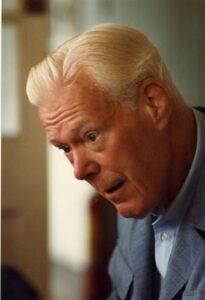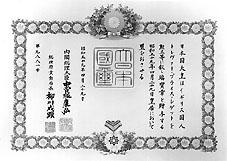
Trevor Pryce Leggett was a multi-talented man who excelled in whatever he seriously set his mind upon. His major interests were Adhyatma Yoga, a well-trodden classical path to the realization of the infinite and all-pervasive Supreme Self, and its non-dualist philosophical basis, Advaita Vedanta; Zen Buddhism; Judo and Japanese culture.
His creative genius gave rise to the production of scholarly and instructive works, Yoga and Zen teaching stories, practical manuals, Sanskrit and Japanese translations and transcriptions as well as his broadcasts to Japan, in his professional capacity as head of the BBC’s Japanese service. Among the set of brilliant talents that constituted his personality, two qualities in particular enabled Trevor Leggett to succeed in making a profound contribution, not only in terms of his life’s productive output, but upon the lives of others. His intelligence determined the effort, training and discipline necessary in a given field, born of the ability to clearly envisage the goal. His strength of character provided the will and determination and the efficient use of his energy to shape his destiny.
He was a translator and author of some thirty books mostly on Eastern and Far Eastern yoga and Zen, with some cross-cultural studies. Three of them in Japanese. He also held the rank of 6th Dan in Judo from Kodokan, Tokyo and 5th Dan in Shogi, Japanese chess. In 1984 he was awarded the Third Degree of the Order of the Sacred Treasure, by the Emperor of Japan, in recognition of his services to cross-cultural relations between East and West, through broadcasting, translations and other books, and through active introduction of aspects of Japanese culture to the West. There are eight degrees of this Order, from the First down, and this is the Third Grade, which is in practice the highest a private individual can get.
In 1987 he was awarded the All-Japan Buddhist Association Literary Award for Translations of Japanese.

Dr. Hari Prasad Shastri was Trevor Leggett’s spiritual teacher. Dr. Shastri, who had direct experience of what he taught, arrived in England to present the teachings of Adhyatma Yoga (the Yoga of the Higher Self) in 1929 after having spent a period of time in both China and Japan, lecturing on Indian philosophy, translating scriptural works and founding publications, among other things. Hari Prasad Shastri was a Sanskrit scholar and was also versed in Chinese, Japanese and Persian languages and literature. Trevor Leggett later worked with Dr. Shastri on the translation of Japanese poems and text that Dr. Shastri used in his reminiscences “Echoes of Japan”.
Dr. Shastri claimed that he was looking for ‘teachability’ in his pupils. Trevor Leggett possessed it in abundance. Trevor Leggett looked for authoritative knowledge and experience in a teacher. He saw that Dr. Shastri discouraged personal adulation and interest; the pupils’ sight was to be focused on the highest spiritual goal, transcending limitations of mind, body and personality. Trevor Leggett, who played chess at London University, under the captainship of Golombek, would win when Dr. Shastri invited him to play with him. Eventually, the young Trevor Leggett realized that Dr. Shastri was using the time to illustrate different teaching points; Trevor Leggett was under no doubt that this spiritual teacher had mastered, not mere techniques, but the great things of life. Dr. Shastri’s responses to Trevor Leggett’s probing questions revealed first-hand experience that superseded anything to be found in books. The teacher’s indisturbable serenity, too, under adverse circumstances and situations pointed to a genuine enlightened man. Training under Dr. Shastri, Trevor Leggett refined and honed his own mind and character, turning these assets, not to egoistic use, but in pursuit of higher aspirations and understanding. The validity of the Yoga and its philosophy lies in its practical application to the inner search for the supramental realm. Trevor Leggett applied the disciplines of the Yoga to awaken his intuitive faculties through profound meditation practice. Dr. Shastri’s daily outpouring of talks, papers, articles, poems and letters was extraordinary and Trevor Leggett inculcated the same urgency to waste no time. Trevor Leggett’s actions, thoughts and speech became, in time, purposefully constructive and one-pointed.
Two years prior to meeting Dr. Shastri, Trevor Leggett had read one of his books: “Wisdom from the East”. In 1937 Trevor Leggett began to attend Dr. Shastri’s lectures on Yoga and Indian philosophy. The 23 year old Trevor Leggett was then interested in mastering a yoga technique that would give confirmable results in his worldly endeavors, particularly in Judo. He had derived enormous energy from the meditation practice that he had carried out for the past ten years, and from pranayama practice. Dr. Shastri emphasized the disadvantages to spiritual progress of acquiring supernormal mental and physical powers for their own sake. Dr. Shastri also told Trevor Leggett that the disciplines of the classical Yoga were complete in their ability to reveal, in the ready pupil, the goal of enlightenment. Trevor Leggett was, at that time, less than enthusiastic about the ethical aspects of the teachings such as ‘purification of the mind’. Under Dr. Shastri’s instruction, together with study of the Yoga classics, principally the “Bhagavad Gita” and “The Upanishads”, and the application of the Yoga disciplines (notably, enquiry, non-attachment and discrimination of the illusory not-Self from the Self, and meditation) the young man grasped the necessity for stripping away the obstacles, in the form of egoism and false convictions of the mind and body. This was an essential discipline that he likewise met in Zen Buddhism. As an indication of Trevor Leggett’s inner change, the subject of ‘purification of the mind’ in preparation for the dawn of spiritual knowledge, based on Bhagavad Gita verses, was a major theme in his later lectures and retreats that he led. Similarly, the young Trevor Leggett had disdained the repetition of verses in Sanskrit, followed by English, until he realized that the complexities of concepts were served best in the original language. In 1978 the mature Trevor Leggett published “The Chapter of the Self”, the Sanskrit of Shankara (the great eighth century Advaita exponent) and in 1989 translated a newly discovered text: “Shankara on The Yoga Sutras”, in two volumes.
An enhanced concern for exactitude and precision, in thought and practice, was Trevor Leggett’s legacy from his law degree. Teamed with his skills as an interesting, lively and engaging broadcaster, with a keen sense of humour, often self-directed, he disallowed wishy-washy thinking or the temptation to pass over a point in study and encouraged the use of vivid examples from experience to illustrate concepts, as he did himself. In this way, Trevor Leggett brought the ancient texts of the Bhagavad Gita and the Upanishads, not only to life, but into significant relationship with students and listeners.
Dr. Shastri, like his own teacher, before him, embraced the universality of spiritual truth. The Sufi teachings of Rumi, the character of Kobo Daishi, the text of St. John’s Gospel were all equally revered as sources of understanding. Trevor Leggett had a sound knowledge of New Testament verses and encouraged meditation on key scenes of Jesus’ ministry and to penetrate the hidden meaning in Christ’s parables. It was with Dr. Shastri’s blessings that Trevor Leggett developed a love and understanding of Zen Buddhism. The differences between the two paths of Yoga and Zen are more apparent than real. Bodhidharma brought Buddhism from India to China, where it took its Zen form and from there it reached Japan. The fertile Indian mind has provided the highest of positive descriptors to the hidden, subtle and spiritual substratum of Man and the universe: “Existence, Consciousness and Bliss” it says of a Supreme identity. Buddhism, without logical predilections, pins the emphasis on practical experience and steers clear of description that might categorize, with the danger of imposing mental limitations. The negative declarations of “Emptiness” and “without definite existence” are traditional. However, the classical Yoga, similarly, declares “Neti, neti” – “Not this, not this”, pointing to a transcendent principle beyond description, or concept and the positive “Existence” transcends the concept of an existing object. Neither “existent, nor non-existent”, Shankara indicates. Both paths are based on meditative search and experience, and both aim at release from the illusory bonds of body and mind identification. Trevor Leggett’s translation of “The Religion of the Samurai” by the twentieth century historian Kaiten Nukariya demonstrates a movement within Zen, to the use of positive statements, such as “Creator”, “universal spirit”.
Trevor Leggett studied under Dr. Shastri until Hari Prasad Shastri’s death in 1956. Trevor Leggett dedicated many of his books to him. Trevor Leggett’s dedication in “The Old Zen Master” runs: “To the late Dr. Hari Prasad Shastri, who introduced me to Zen in its original Indian form, in whom the ancient traditions were always young, these pieces are reverently dedicated by his pupil.”
Trevor Leggett’s published books pertaining to Adhyatma Yoga include: “The Chapter of the Self”, “Shankara on the Yoga Sutras” volume 1 and 2, “Encounters in Yoga and Zen” and Realization of the Supreme Self”.
His books include the following titles:
| A First Zen Reader |
| A Second Zen Reader:The Tiger’s Cave and Translations of Other Zen Writings |
| Championship Judo: Tai-otoshi and O-uchi-gari Attacks |
| Encounters in Yoga and Zen |
| Il vecchio maestro zen: idee per un risveglio consapevole |
| Japanese Chess: The Game of Shogi |
| Lotus Lake Dragon Pool |
| Racconti yoga e zen |
| Realization of the Supreme Self: The Bhagavad Gita Yoga |
| Samurai Zen: The Warrior Koans |
| Sankara on the Yoga Sutras: A Full Translation of the Newly Discovered Text |
| Shogi: Japan’s Game of Strategy |
| The Chapter of the Self |
| The Dragon Mask and Other Judo Stories in the Zen Tradition |
| The Old Zen Master: Inspirations for Awakening |
| The Spirit of Budo |
| The Warrior Koans: Early Zen in Japan |
| Three Ages of Zen: Samurai, Feudal, and Modern |
| Zen and the Ways |